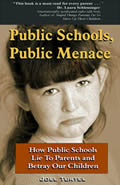Other Guest Articles:
Jury Rights! Jury
Nullification
Constitutional
Tools No
Longer Valid
REDEFINING EDUCATION FOR GLOBAL CITIZENSHIP

By Debbie K. Niwa
February
21, 2006
NewsWithViews.com
Global education reforms lurk behind the changes being foisted on U.S. schools: redesigning American high schools, promoting universal preschool, expanding technology, increasing data collections, linking secondary and higher education, and more. But where will these lead? In revisiting the old ideas behind reforms, we would be wise to ask, �Do we want the kind of life these changes will bring?�
Lifetime monitoring
Imagine all facets of your life � school, work, health, leisure, and spiritual � monitored and assessed from birth-to-death through one comprehensive �system.� Under the banner of �lifelong education,� such a system is evolving.
Promoted through United Nations Educational, Scientific, and Cultural Organization (UNESCO) and the Organisation (sic) for Economic Co-Operation and Development (OECD), the lifelong education principle is influencing school, workforce, and economic reforms worldwide.
Despite formal withdrawal from UNESCO in December 1984 by then-President Reagan, the global lifelong education scheme nevertheless began spreading throughout the U.S. during the nearly 19 year period of non-membership.
Long before President G.W. Bush rejoined the U.S. with UNESCO in 2003, the UNESCO-endorsed idea received U.S. tax dollars through federal laws that funded different aspects of the principle.
Upheavals in education are linked to building the system. Included are efforts to: combine the academic with the vocational for all students; use technology for teaching, training, and data collections; eliminate public control through creation of appointed councils; establish school-business partnerships; and much more.
Technology in particular � combined with surveys, assessments, and evaluations � plays an indispensable data gathering role for monitoring individuals and forcing accountability to those with the power to dictate the systems� goals.
Strip away the hype �about equality, justice, diversity, human rights, and 21st century workplace skills � and what remains is nothing less than a global system of social and economic control.
Lifelong social engineering
In 1973, UNESCO published Towards a conceptual model of life-long education by George W. Parkyn. Explained in the preface, the lifelong education concept underlies all of UNESCO�s educational action. With that in mind, the publication studies � beginning in 1971 � were conducted to �outline a possible model for a system based on the ideal of a continuous educational process throughout the lifetime of the learner� and �if possible, indicate the means for bringing an existing national school system into line with life-long learning.� (p.3) [Emphasis added]
Parkyn explains, �A comprehensive model for life-long education needs to start with two basic dimensions: first, the span of a human lifetime, and second, the range of human behaviour.� (p.19) He asserts that establishing lifelong education requires �radical changes in the structures, functions, methods, and content of education systems at all levels . . .� (p.15)
With lifelong education, the traditional goal to develop the intellect is replaced with an emphasis on attitudes, values, habits, and social behaviors.
Parkyn explains that the focus of childhood and adolescent education needs �to aim at producing not educated people but educable people . . . � Another aim is to produce �people who are adaptable in changing circumstances, who realize the provisional nature of knowledge, the tentative nature of decisions, and the need for constant evaluation of the results of their actions . . . � (p.17)
With lifelong education, K-12 school systems link to higher education; universal infant care and preschool are added; and elementary and secondary levels transform as follows:
Basic general education (ages 6-15): The first five years, a child is introduced �to the universe of space and time in which he and his community are located, to open up to him through his own activities the wide range of interests and potentialities. . . to lay the foundations of those learning skills and interests on which subsequent development will depend.� (p.39)
The next four years start the �process of educational and vocational choice.� By the end of this �transitional cycle,� children pick �a provisional field of employment.� (p.39-40)
Secondary education (ages 15-18): This three-year period consists of �part schooling and part working.� Successes are noted for China and the former USSR:
�Many attempts have been made to devise a method that satisfactorily combines general education, vocational education and specific vocational training during this period, and for some occupations considerable success has been achieved notably in the USSR and in China.� (p.40)
Lifelong education also involves expanding adult education to address economic, political, and personal needs (p.12); use of Marx�s theory and practice (p.14); occupational training and retraining (p.24); integrating culture and vocation (p.28); self-education (p.31); certification (p.31); centralization of general policy making (p.32); and more.
Putting the nation at risk
Fast forward to 1981 when President Reagan�s Secretary of Education Terrel Bell established the National Commission on Excellence in Education. Charged with reporting on the �quality of education in America,� the Commission�s findings and suggestions were published in A Nation at Risk: The Imperative for Educational Reform (1983). The report�s criticism of U.S. education launched efforts to bring American schools in line with UNESCO�s lifelong education plans.
Comments in the report include: �The world is indeed one global village�; � . . . we must dedicate ourselves to the reform of our educational system for the benefit of all � old and young alike, affluent and poor, majority and minority�; �The search for solutions to our educational problems must also include a commitment to life-long learning�; � . . . life-long learning will equip people with the skills required for new careers and for citizenship.� [Emphasis added]
Since A Nation at Risk was published, U.S. presidents have presented similar lifelong education supporting plans. A Feb. 4, 1994 Congressional Record entry by then-Senator Moynihan (NY) reveals:
�In 1984, President Reagan proposed a set of education goals to be achieved by 1990. And in 1990, President Bush devoted a sizable portion of his State of the Union address to setting forth his education goals for the year 2000 . . . President Bush then listed his education goals, which were similar to President Reagan's goals � and virtually identical to those now proposed by President Clinton.�
A Nation At Risk provided excuses to begin nationwide school reform, but the report was flawed in its assessment of U.S. schools. Stated in a paper prepared for the National Education Goals Panel:
�. . . A Nation at Risk may have been flawed as an accurate, balanced assessment of American schooling in the early 1980s, but it was a key factor in mobilizing public opinion on behalf of educational reforms. And while the reforms that it helped to stimulate were not enough by themselves to increase sufficiently student achievement in the 1980s, the report was followed by other initiatives focused more on the restructuring of the schools.� (The Road to Charlottsville � The 1989 Education Summit, 1999, p.12)
Community Education
Charlotte T. Iserbyt, author of the deliberate dumbing down of america . . . A Chronological Paper Trail (1999, 2000, 2001), served as an OERI Senior Policy Advisor in the U.S. Dept. of Education during the Reagan administration. Her article �Death Sentence for Private and Home Education, Courtesy of Supreme Court,� (7-8-2002) identifies a key intention behind school reform. In 1981, Iserbyt was informed by the Director of the Office of Libraries and Learning Technology, U.S. Dept. of Education: �. . . in the future all education will take place in the home, using computer-assisted-instruction, but that we will always have the school buildings for 'socialization' purposes.�� Iserbyt explains, �This is the United Nations lifelong learning/brainwashing concept (International community education) which places all community services under the umbrella of the community school. The National Alliance of Business refers to this agenda as Kindergarten-Age 80.�
UNESCO & vocational education
On November 10, 1989 in Paris, the Convention on Technical and Vocational Education was adopted by the UNESCO General Conference. U.S. school reform goals since the 90�s have been strikingly aligned with Article 3, section 2 of the Convention:
�Technical and vocational education should be designed to operate within a framework of open-ended and flexible structures in the context of lifelong education and provide: (a) an introduction to technology and to the world of work for all young people within the context of general education. (b) educational and vocational guidance and information, and aptitude counselling; (c) development of an education designed for the acquisition and development of the knowledge and know-how needed for a skilled occupation; . . .� [Emphasis added]
For-profits brought on-board
The 1991 creation of the New American Schools Development Corporation (NASDC, later shortened to New American Schools) was part of President Bush Sr.�s America 2000 plan to finance development of new models for U.S. schools.
NASDC funded nine groups between 1993-1995. Selecting for-profit partners like the NCEE (see below), awardees formulated what amounts to strategies to institutionalize key elements of a human resource system (community/lifelong education). Noted in Iserbyt�s the deliberate dumbing down of america, NASDC and partners have been on the front lines promoting business-school partnerships, charter schools, choice, and vouchers � all of which facilitate systemic reform.
The National Center on Education and the Economy (NCEE, est. 1988; formerly the Carnegie Forum on Education and the Economy) has prominently supported lifelong education. Included among the 1988 NCEE Board of Trustees were Marc Tucker (President), Hillary Clinton, Mario Cuomo, Ira Magaziner, Lauren Resnick, John Sculley, James B. Hunt, Jr., Anthony Carnevale, David Rockefeller, Jr., Vera Katz, and others.
The NCEE�s 1992 A Human Resources Development Plan for the United States suggested �a national system of education in which curriculum, pedagogy, examinations and teacher education and licensure systems are all linked to the national standards, . . .� The new system would qualify �all students for a lifetime of learning in the postsecondary system and at work.� [Emphasis added]
In a Nov. 11, 1992 letter to Hillary Clinton, NCEE�s Marc Tucker wrote extensively about a �human resources system� . . . a �seamless web� that �literally extends from cradle-to-grave and is the same system for everyone � young and old, poor and rich, worker and fulltime student� . . . for a �lifetime of learning.� (Congressional Record, 9-17-98)
U.S. Dept. of Labor�s SCANS
The U.S. Department of Labor�s Secretary�s Commission on Achieving Necessary Skills (SCANS) began publishing documents between 1990-1993 suggesting systemic school reforms that included integrating technical/vocational and general education for all students.
What Work Requires of Schools, A SCANS Report for America 2000 (1991) highlights the link between Bush Sr.�s America 2000 and UNESCO�s lifelong education: �The strategy [America 2000] would change lifelong learning from a slogan to a reality for all.� (p.20)
Vo-tech paves the way
Federal laws supporting vocational and technology plans boosted U.S. adoption of lifelong education. Explained in �The Impact of School-to-Work and Career and Technical Education in the United States: evidence from the National Longitudinal Survey of Youth, 1997,� by James R. Stone III:
�The 1990 Carl D. Perkins Vocational and Applied Technology Education Act (�Perkins II�) mandated that federally-funded CTE [Career Technical Education. �Ed.] programs develop the following: tech prep programs; integration of vocational and academic curricula; promotion of work-related experience; and accountability for funding continuation. [Emphasis added]
�Building on Perkins II, Perkins III expanded the goals of CTE to include:
- Integrate academic
and vocational education.
- Promote student
attainment of challenging academic and vocational standards.
- Provide students
with strong experience in, and understanding of, all aspects of an industry.
- Involve parents
and employers.
- Provide strong
connections between secondary and post-secondary education.
- Develop, improve,
and expand the use of technology.
- Provide professional development for teachers, counselors and administrators.� (Journal of Vocational Education and Training, Vol. 54, No. 4, 2002)
Of interest, Stone observes, �The notion of curriculum integration goes back almost a full century to John Dewey (1916).�
U.S. Federal aid
The bulk of federal funds and promotion for global education reform were secured in laws enacted during President Clinton�s terms. Different aspects were split among Goals 2000: Educate America Act (1994), School-to-Work Opportunities Act (1994), Improving America�s Schools Act (1994, an ESEA reauthorization), Workforce Investment Act (1998), Perkins III (1998), and others.
UNESCO education reforms currently continue through President Bush�s No Child Left Behind Act. At the February 2005 EFA (Education for All) conference, Secretary of Education Margaret Spellings stated: �The No Child Left Behind Act and UNESCO's Education for All campaign complement each other.� (�Mrs. Laura Bush Pays Tribute to UNESCO's Education for All Week,� U.S. Dept. of Education, 4-27-2005)
State boards of education rallied
In 1995, Framework for the Future: Creating a School-to-Work System for Learning, Livelihood, and Life was published by the National Association of State Boards of Education (NASBE) School-to-Work Study Group. The NASBE report encouraged the restructuring of American schools in-line with lifelong education:
�Developing the capacity of all citizens for . . . lifelong learning is an absolute necessity . . .� (p.4) [Emphasis added]
�Meeting this need [to create a �comprehensive and coherent system�] will require the development of a new school-to-work system able to educate all students . . . and teach them to be lifelong learners. It must be based on learning that is relevant to the real world; curriculum that incorporates career preparation; and experience in a workplace or community setting for all students.� (p.4) [Emphasis added]
�(2) State boards must ensure that SCANS and other work-related skills areas are incorporated into state performance standards, curricular frameworks and assessments, as well as the state accountability system.� (p.5)
�In 1994, three federal initiatives were passed that sought to consolidate these discreet efforts, . . . The Goals 2000: Educate America Act, Improving America�s Schools Act . . . and the School-To-Work Opportunities Act, taken together, offered a blueprint for the creation of a new education paradigm. . . . for all students.� (p. 11-12)
Using schools for planned change
Twenty years ago in Iserbyt�s 1985 booklet Back to Basics Reform or . . . OBE Skinnerian International Curriculum, the author warned: the �educational system [would be used] as the primary vehicle for bringing about planned social, political, and economic change.� Iserbyt also noted that technology use would result in stifling intellectual development. [This aids the lifelong education aim to produce �not educated people but educable people.� �Ed.] The warning unheeded, schools today are focusing on non-academic standards � under the pretense of workplace and life skills � to advance planned changes.
Poised to sit at the helm of the global system is the United Nations and its agencies like UNESCO, World Bank, WTO, WHO, ICC, and other entities situated to regulate a part of the system.
In the first half of the 20th century, the League of Nations failed to establish itself for governance and was replaced by the United Nations in 1945. With U.N. agencies and partners promoting global initiatives � lifelong education, world citizenship, international standards setting, free trade and sustainable development schemes eroding national economic control, and other national sovereignty encroaching activity�the U.N. is not far from establishment as a world governing body.
|
Subscribe to the NewsWithViews Daily News Alerts! |
The chance of living under oppressive U.N. global authority surely rests upon whether or not determination exists to uphold individuality, liberty, and a Constitutional Republic for serving (not enslaving) citizens. One can only hope the hundreds of thousands throughout America�s history, who risked their lives to uphold these ideals, will not have done so in vain.
RESOURCES:
1.
Towards a conceptual model of life-long education, George W. Parkyn, UNESCO,
Paris, France, 1973. English Edition ISBN 92-3-101 1174, French Edition
ISBN 92-3-201117-4.
2. A Nation at Risk: The Imperative for Educational Reform, National
Commission on Excellence in Education, U.S. Department of Education, 1983.
3. Back
to Basics Reform or . . . OBE Skinnerian International Curriculum,
Charlotte Thomson Iserbyt, 1985.
4. The Road to Charlottsville -The 1989 Education Summit, Maris
A. Vinovskis, Department of History, Institute for Social Research, and
School of Public Policy, University of Michigan, September 1999. Paper
prepared for the National Education Goals Panel.
5. Convention on Technical and Vocational Education, adopted by
the UNESCO General Conference, Paris, November 10, 1989.
6. "Dollars to the Classroom Act," Congressional Record, Sept.
17, 1998, pp. E1819-E1825. Entry contains the letter to Hillary Clinton,
Nov. 11, 1992 written by Marc Tucker (National Center on Education and
the Economy, Rochester, NY).
7. What Work Requires of Schools, A SCANS Report for America 2000,
U.S. Department of Labor, Secretary's Commission on Achieving Necessary
Skills, 1991
8. A Human Resources Development Plan for the United States, National
Center on Education and the Economy (NCEE), 1992.
9. Remarks by Senator Moynihan (NY), Congressional Record, February
4, 1994, Online at GPO Access. Accessed December 2005.
10. Framework for the Future: Creating a School-to-Work System
for Learning, Livelihood, and Life, Report of the National Association
of State Boards of Education (NASBE) School-to-Work Study Group, 1995.
11. Tangled Web-The Mastery Learning/OBE/STW-TQM Connection, researched
and compiled by Joe Esposito, 1996, 1997.
12. "Background of 'School-to-Work' Concept," D.L. Cuddy, Ph.D.,
Extension of Remarks-May 16, 1997, Congressional Record, pp. E945-E946.
13. "International Implications of School-to-Work Programs," D.L.
Cuddy, Ph.D., Extension of Remarks-June 26, 1998, Congressional Record,
pp. E1274-E1275.
14. the deliberate dumbing down of america . . . A Chronological
Paper Trail , Charlotte Thomson Iserbyt, Conscience Press, 1999, 2000,
2001. Go to deliberatedumbingdown.com
and click on "e-book download free to all."
15. "Death
Sentence for Private and Home Education, Courtesy of Supreme Court,"
Charlotte Thomson Iserbyt, NewsWithViews.com, July 8, 2002.
16. "The Impact of School-to-Work and Career and Technical Education
in the United States: evidence from the National Longitudinal Survey of
Youth, 1997," James R. Stone III, University of Minnesota, Saint Paul,
Journal of Vocational Education and Training, Vol. 54, No. 4, 2002
17. "Laura Bush named Honorary Ambassador for the United Nations
Decade of Literacy", Office of the Spokesperson, UNESCO, February 14,
2003.
18. "First Lady Laura Bush Says U.S. Is Proud to Rejoin UNESCO,"
U.S. Department of State, Office of International Information Programs,
September 29, 2003.
19. "Mrs. Laura Bush Pays Tribute to UNESCO's Education for All
Week," U.S. Department of Education, Press Release, April 27, 2005.
� 2006 - Debbie K. Niwa - All Rights Reserved
Sign Up For Free E-Mail Alerts
E-Mails are used strictly for NWVs alerts, not for sale
Debbie Niwa began researching education issues five years ago when she started questioning the policies and changes occurring in the school district in Tucson, Arizona that her son was enrolled in. She has devoted thousands of hours researching local, state, federal, and global school reform issues, as well as actively advocating for academic quality in education. Since 1980, she has worked professionally on the design and production of publications as well as the gamut of other graphic design projects.
E-Mail: ed.insight@gmail.com
With lifelong education (learning), the traditional goal to develop the intellect is replaced with an emphasis on attitudes, values, habits, and social behaviors.













